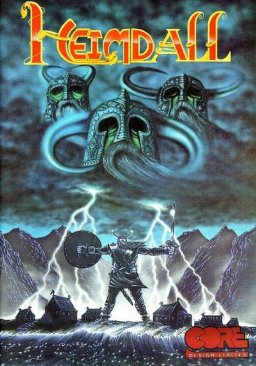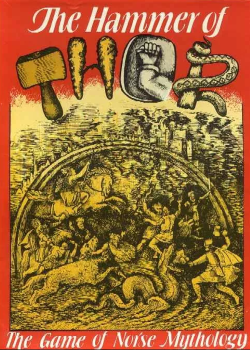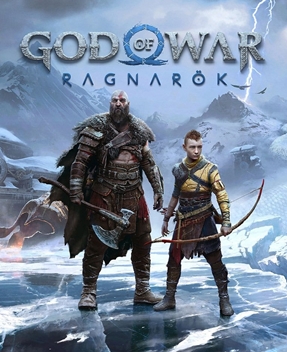In Nordic mythology, Asgard is a location associated with the gods. It appears in several Old Norse sagas and mythological texts, including the Eddas, however it has also been suggested to be referred to indirectly in some of these sources. It is described as the fortified home of the Æsir gods and is often associated with gold imagery and contains many other locations known in Nordic mythology such as Valhöll, Iðavöllr and Hlidskjálf.

In Norse mythology, Heimdall is a god. He is the son of Odin and nine mothers. Heimdall keeps watch for invaders and the onset of Ragnarök from his dwelling Himinbjörg, where the burning rainbow bridge Bifröst meets the sky. He is attested as possessing foreknowledge and keen senses, particularly eyesight and hearing. The god and his possessions are described in enigmatic manners. For example, Heimdall is golden-toothed, "the head is called his sword," and he is "the whitest of the gods."

In Norse mythology, Ragnarök is a foretold series of impending events, including a great battle in which numerous great Norse mythological figures will perish ; it will entail a catastrophic series of natural disasters, including the burning of the world, and culminate in the submersion of the world underwater. After these events, the world will rise again, cleansed and fertile, the surviving and returning gods will meet, and the world will be repopulated by two human survivors, Líf and Lífþrasir. Ragnarök is an important event in Norse mythology and has been the subject of scholarly discourse and theory in the history of Germanic studies.

Týr is a god in Germanic mythology and member of the Æsir. In Norse mythology, which provides most of the surviving narratives about gods among the Germanic peoples, Týr sacrifices his right hand to the monstrous wolf Fenrir, who bites it off when he realizes the gods have bound him. Týr is foretold of being consumed by the similarly monstrous dog Garmr during the events of Ragnarök.

In Norse mythology, Jörmungandr, also known as the Midgard Serpent or World Serpent, is an unfathomably large and monstrous sea serpent or worm who dwells in the world sea, encircling the Earth (Midgard) and biting its own tail, an example of an ouroboros. As a result of his surrounding Midgard, the beast is referred to as the World Serpent. Jörmungandr releasing his tail is one of the signs of the beginning of Ragnarök.

Ragnarok Online is a massive multiplayer online role-playing game (MMORPG) created by Gravity based on the manhwa Ragnarok by Lee Myung-jin. It was released in South Korea on 31 August 2002 for Microsoft Windows. The game has spawned an animated series, Ragnarok the Animation, and a sequel game, Ragnarok Online 2: Legend of the Second. The player's characters exist in a world with a player environment that includes NPC's that can be interacted with, and creatures spawning in maps that need to be defeated to level-up and to acquire items.

Age of Mythology is a real-time strategy video game developed by Ensemble Studios and published by Microsoft Game Studios. It was released on October 31, 2002 in North America and on November 14, 2002 in Europe.

Heimdall is a fictional character appearing in American comic books published by Marvel Comics. The character is based on the Norse deity Heimdall. Heimdall is described as all-seeing and all-hearing and is the sole protector of the Bifröst in Asgard.

Heimdall is an action role-playing game developed by The 8th Day, published by Core Design, and released in 1991 for the Amiga and for the Atari ST and DOS in 1992, with a console version created for the Sega Mega-CD in early 1994. The game features a mixture of puzzle-solving, exploration, and dynamic combat mechanics, where players must explore various islands in the search for the fabled weapons belonging to the gods of Norse mythology. The game received favourable reviews upon its release, though the console version was given mixed feedback by reviewers.
The Norse mythology, preserved ancient Icelandic texts such as the Poetic Edda, the Prose Edda, and other lays and sagas, was little known outside Scandinavia until the 19th century. With the widespread publication of Norse myths and legends at this time, references to the Norse gods and heroes spread into European literary culture, especially in Scandinavia, Germany, and Britain. In the later 20th century, references to Norse mythology became common in science fiction and fantasy literature, role-playing games, and eventually other cultural products such as Japanese animation. Storytelling was an important aspect of Norse mythology and centuries later, with the rediscovery of the myth, Norse mythology once again relies on the impacts of storytelling to spread its agenda.

Ragnarok is a freeware Roguelike video game for MS-DOS, developed by Norsehelm Productions from 1992 to 1995.

The Warriors Three are a group of fictional characters appearing in American comic books published by Marvel Comics. The characters served as supporting cast members in Thor. The Warriors Three are the Asgardians Fandral, Hogun, and Volstagg. Though the characters are gods of Asgard, they are original creations of Marvel Comics and not based on characters from Norse mythology.
The bound monster is an important motif in Norse mythology. The theme is that of an enemy of the gods who is bound or restrained in some way but destined to break free during the time of Ragnarök to cause destruction.

Surtur is a fictional character appearing in American comic books published by Marvel Comics, commonly as an enemy of Thor. Based on the fire giant Surtr from Norse mythology, he was adapted by writer Stan Lee and artist Jack Kirby, and first appeared in Journey into Mystery #97. The character was once described as one of "The Ten Most Heinous Enemies of the Mighty Thor".
Jul i Valhal is a Danish television advent calendar. It first aired in the December 2005 on TV 2 Denmark television station, on TV 2 Norway in December 2006, in December 2007 on Swedish Barnkanalen and in December 2008 on Yle2. As a television advent calendar, it has 24 episodes, and one new episode was aired per day from 1 to 24 December.
God of War is an action-adventure game franchise created by David Jaffe and developed by Sony's Santa Monica Studio. It began in 2005 on the PlayStation 2 (PS2) video game console and has become a flagship series for PlayStation, consisting of nine installments across multiple platforms. Based on ancient mythologies, the series' plot follows Kratos, a Spartan warrior who becomes the God of War and comes into conflict with various mythological pantheons. The earlier games in the series are based on Greek mythology and see Kratos follow a path of vengeance against the Olympian gods; the later games are based on Norse mythology and see Kratos on a path of redemption while also introducing his son Atreus as a secondary protagonist, as they come into conflict or interact with various Norse deities and figures.

The characters of the God of War video game franchise belong to a fictional universe based on Greek mythology and Norse mythology. As such, the series features a range of traditional figures, including those from Greek mythology, such as the Olympian Gods, Titans, and Greek heroes, and those from Norse mythology, including the Æsir and Vanir gods and other beings. A number of original characters have also been created to supplement storylines.

"The Roaring Trumpet" is a fantasy novella by American writers L. Sprague de Camp and Fletcher Pratt. The initial story in their Harold Shea series, it was first published in the May 1940 issue of the fantasy pulp magazine Unknown. It first appeared in book form, together with its sequel, "The Mathematics of Magic", in the collection The Incomplete Enchanter, issued in hardcover by Henry Holt and Company in 1941, and in paperback by Pyramid Books in 1960. It has since been reprinted in various collections by numerous other publishers, including The Compleat Enchanter (1975), The Incompleat Enchanter (1979), The Complete Compleat Enchanter (1989), and The Mathematics of Magic: The Enchanter Stories of L. Sprague de Camp and Fletcher Pratt (2007). It has been translated into Dutch and Italian. In 2016, the story was shortlisted for the Retro Hugo Award for Best Novella.

The Hammer of Thor is a board game for 2–362 players published by Nova Game Designs in 1980.

God of War Ragnarök is a 2022 action-adventure game developed by Santa Monica Studio and published by Sony Interactive Entertainment. It was released worldwide on November 9, 2022, for both the PlayStation 4 and PlayStation 5, marking the first cross-generation release in the God of War series, and was released for Windows on September 19, 2024. It is the ninth installment in the series, the ninth chronologically, and the sequel to 2018's God of War. Loosely based on Norse mythology, the game is set in ancient Scandinavia and features series protagonist, Kratos, and his now teenage son, Atreus. Concluding the Norse era of the series, the story follows Kratos and Atreus' efforts to prevent the nine realms from being destroyed by Ragnarök, the eschatological event which is central to Norse mythology and was foretold to happen in the previous game after Kratos killed the Aesir god Baldur.














